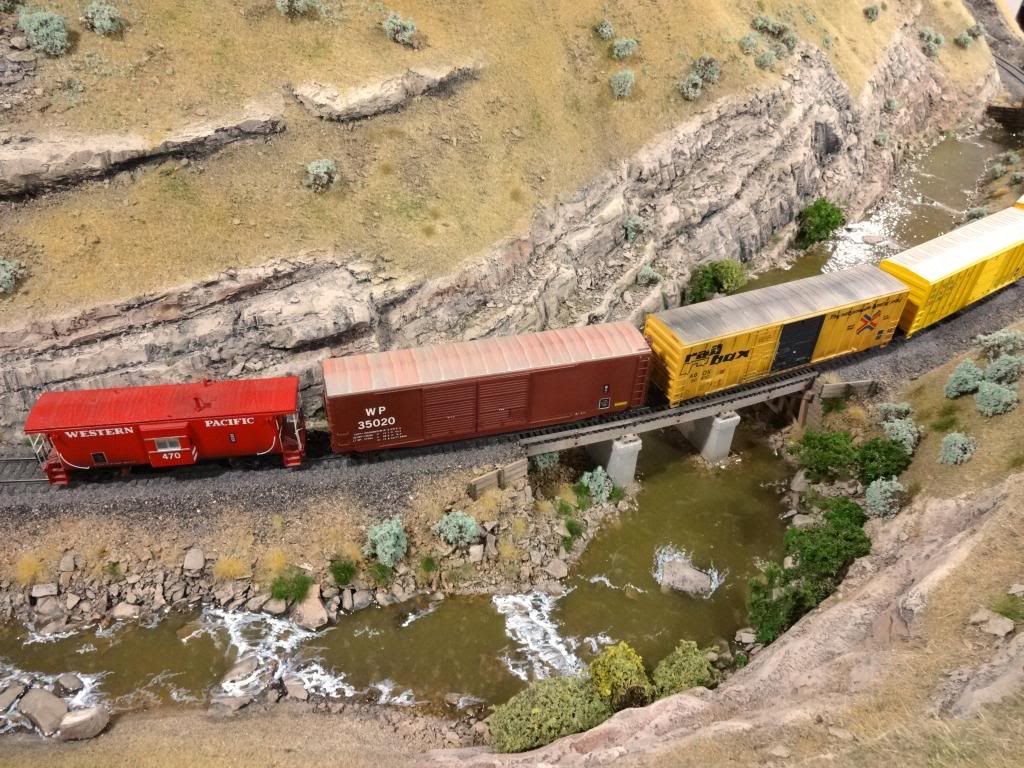Looking to broaden my expertise, I want to try to create realistic cliff-bottom rock fall. An example from a book appears below. If any of the forum members can share a favorite technique or method, it would be appreciated.
Wilton.
Looking to broaden my expertise, I want to try to create realistic cliff-bottom rock fall. An example from a book appears below. If any of the forum members can share a favorite technique or method, it would be appreciated.
Wilton.
The tallus will vary from the type of rock it fell from. Many times when using this from the granite cuts and outcroppings broken pieses of Hydrocal work in my instance. Of coarse the tallus needs to be colored to the rock face from which it fell. Real rock, gravel etc may work in some instances. it can always be used as a base that will be dressed w/ some of the smaller stuff.
Woodland Scenics has bags of different color tallus. Most of it is rounded stone that could simulate river rock as well.
I save the left over plaster from my rock casting efforts and break it into small pieces to use for talus. I sort it into a series of sized pieces and color it with the same stains/washes that I use for the rock castings.
Joe
A good aquarium shop will have a large slection of sand and gravel types. Depending on the rock you are modeling you can take your pick of rounded or sharp of all sizes. Also take a hammer to it, if need be. It has to be the colour of the face it fell from so put it in a zip lock with a little paint, shake and let dry on an old pan. After when in place, dry brush, and maybe sprinkle a bit of weathering powder on it and run a dry brush over it and then give a light spray with an india ink wash.
Experimentation is a wonderful way to learn. Good luck.
besides natural stuff you can sift. Arizona rock and minerals has a good selection in various colors. Scenic express has river stone in various sizes incluing mixed river stone. Also look at their heavier ballast colors. Brennens Ballast has some ballast that would work for tallus.
I use real rock that hasn’t been sifted, as talus will include a full range of textures. The smaller (lighter) stuff tends to stay closer to the top, while the heavier pieces roll farther toward the bottom. Always keep prototype photos handy for reference. I secure it with my usual 50:50 water:white glue mixture in most cases, although if the slope is too steep I sometimes apply it over full strength white glue applied with a brush. In the latter cases I often go back after the glue dries and fill in with more glued the “normal” way.
Color doesn’t matter too much. You can paint the talus material to coordinate with your model rocks, using a dry brush, wash, airbrush or however you like.

The talus here is typical of applications on my layout. I dry-brushed the rock after it was glued, using the same acrylic colors I used for the plaster rocks. The natural color was already close enough to blend into the shadows.

This view shows both the color matching effect and the variety of sizes used.

For this spot I avoided the big chunks but still used a range of sizes. The rocks and gray dirt at the top are parts of an embankment that are finished more of less the same way.
Talus blends at its edges with surrounding dirt and sand use for base ground cover. This keeps it from looking like out-of-place random texture.
Globs of solid plaster, break into pieces in a bag with a hammer, color with diluted craft store acrylics.
Wilton,
I use Sculptamold a lot and also embed plaster castings of rocks in it. What I often do is taper the Sculptamold underneath the castings so it forms a talus-like slope. The texture of the Sculptamold actually looks pretty good, even with loose rock on it. I have gone back and added actual talus over a few so far and will eventually get to many others. It’s an easy technique that looks good for now very easily, while setting up easy improvements in the future. Here are a couple of examples.
This location eventually got a snowshed, but you can see the tapering talus slope under the rocks above the line up to Animas Forks.
The cliffs above Tefft had only the long slopes of talus below before I recently installed hundreds of bumpy chenille trees on parts of them, another easy option if it turns out some grenery is better than more rocks.
To the left across the track from the hoodoos is another area with the faked talus slope of Sculptamold.
To all who responded to my post, many thanks for sharing the great tips and samples of your work. I appreciate the advice.
Wilton.